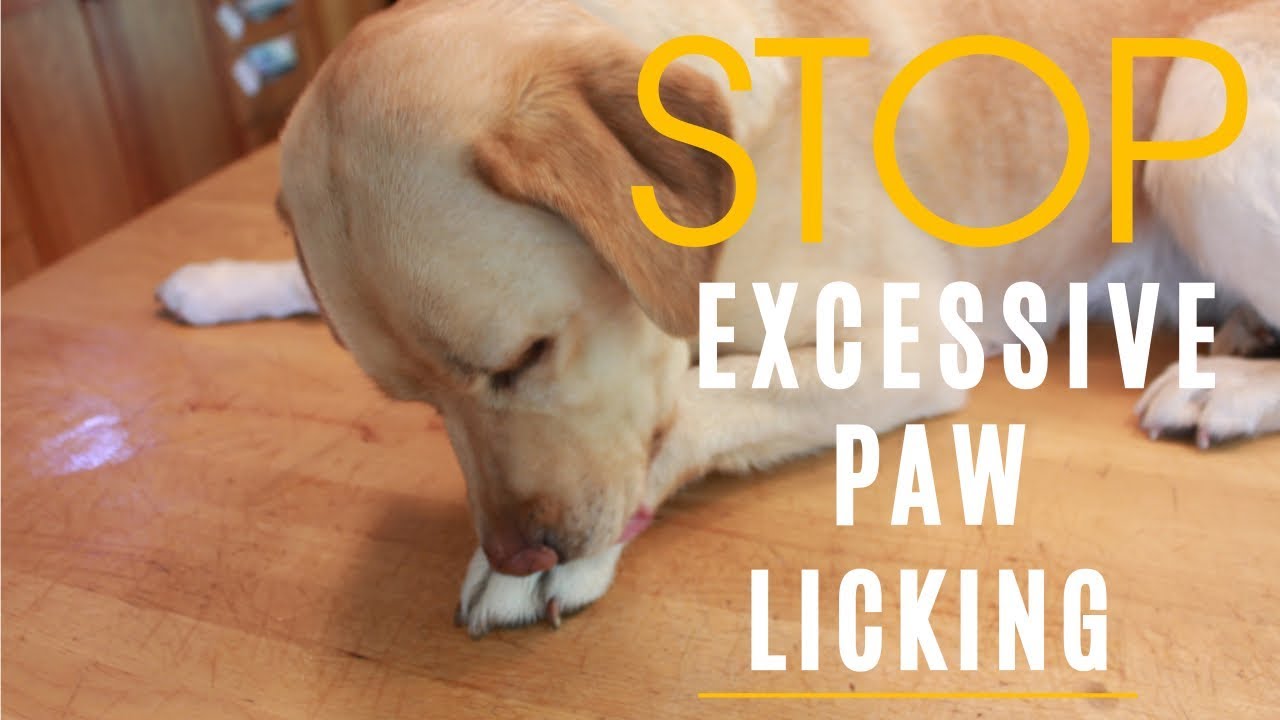Pet excessively licking their paws? It could be this…

Has your pet ever had a health problem that you would like to treat at home, such as excessively licking their paws?
Well this is likely some type of allergy, and we have a few supplements which may help.
The active ingredient in turmeric (95% curcumin), is a wonderful natural anti-inflammatory, and can lessen those reddened, irritated paws. Our BCM High Absorption95% Curcumin has been helping many a pet!
Quercetin, a beneficial flavonoid isolated from apples is considered a potent natural antihistamine to help combat the itch.
We now have a new EXTRA strength whole plant Quercetin, great for medium-large dogs, and our Quercetin supplement has some great reviews:-)

Go here to order now: shop.veterinarysecrets.com
Pet Paw Licking
One of the most frustrating things to see is your pet obsessively licking his paws, especially when that’s all that seems to matter.
Dogs and cats who lick their paws excessively often develop stains on the fur of their feet from their saliva. The area between the pads can be red, inflamed, swollen and painful to touch.
What’s causing it?
There are many possibilities, but the most common cause by far is allergies, with secondary yeast infections.
So what to do?
ANTIHISTAMINES – Benadryl (diphenhydramine) is the most used antihistamine. It is given at a dose of 1 mg per pound of body weight, 2-3 times a day. CETERIZINE (Zyrtec): I have now been using this 24-hour antihistamine on my dogs and cats. It has less side effects than the Benadryl- doses of 5mg/10lbs once daily. It is best to consult your veterinarian before using these medications. It often takes 14 days of using these to see if they are helping.
LICORICE ROOT – Considered ‘natural’ steroid. The dose is ½ ml per 20lbs twice daily of the tincture. Caution if underlying organ dysfunction. Max use for 14 days in a row.
EFA’s (Omega 3 Fatty Acids) – There is more evidence, and clinical results supporting the benefits of EFA’s than any other supplement. The anti-inflammatory components of the Essential Fatty Acids are EPA and DHA can cause a marked decrease in the level of redness and ongoing scratching.
CURCUMIN – 95% curcuminoids can be very helpful to decrease the level of itching and skin inflammation. The dose is 50mg/10lbs of body weight daily. Lower doses of the bioavailable curcumin, and we now have our own BIOAVAILABLE 95% curcumin: https://shop.veterinarysecrets.com/
BIOFLAVONOIDS – Quercetin has been extensively studied, and some researchers claim it is the most beneficial supplement for Seasonal Allergies. It is a flavonoid (beneficial nutrient), that is found in apple peel, red onion. Quercetin displays high antioxidant and anti-inflammatory properties that have been proven by many in vivo and in vitro studies. Quercetin’s anti-allergic mechanism of action through the inhibition of enzymes and inflammatory mediators has also been extensively studied. Standard Quercetin Dose: 50mg/15lbs daily of our whole plant extract, Dr Jones’ Quercetin for Dogs and Cats. https://shop.veterinarysecrets.com/
NEW Homemade Topical Allergy Skin Cream – This works well for any area of red inflamed skin. 3 tablespoons of coconut oil, 2 tablespoons of castor oil, 2 tablespoons of Sunflower oil, 1 tablespoon of Shea butter, plus 2 tablespoons of Beeswax. It needs to be put into a pot, warmed so it is all melted, then poured into glass mason jar. Keep at room temperature. Safe for dogs and cats.
Green Tea anti-yeast Recipe – Here is a topical anti-allergy/anti-yeast recipe that can help, but only for dogs. If using for a cat, eliminate the Lavender oil.
Ingredients
- 1 cup Green tea
- 2 tablespoons Apple Cider Vinegar,
- 1 tablespoon Salt
- 10 drops Lavender Essential Oil
The green tea is antibacterial, the ACV is effective for yeast, the salt is antibacterial and will also take down some of the swelling, and the lavender oil offers anti-yeast and some antihistamine qualities to help with the allergy.
Directions: Brew up 1 cup of green tea, then allow to cool for 15mins. Add in the ACV, Salt and Lavender Oil. Soak the affected feet for 5 minutes twice daily. Assess after 7 days if this is beneficial.

Best Wishes,
Dr. Andrew
P.S. If you have a pet with excessive paw licking, 1st examine the paws. See if anything is stuck in the pads. Look for open wounds. If unsure see your vet.
If though there is staining, and this is an ongoing thing, then most likely allergy caused, so you can consider trying the above recipe.
P.P.S. If you have an itchy pet, consider one of our newish supplements…
Dr Jones’ BCM High Absorption 95% Curcumin has been helping many a pet!
Our new EXTRA strength whole plant Quercetin, great for medium-large dogs, and our Quercetin supplement has some great reviews:-)
Hi Doc. I have a jack Russel with terrible ear problems. They are smelly and inflamed. She tips her head to the sore head and shakes her head often. I have given her ear drops for ear canker, and while I am dissing her it’s ok but when I stop it’s comes back again. Please help!
Here are some helpful tips:
Infections of the external ear canal (outer ear) by bacteria or yeast, are one of the most common types of infections seen in dogs. We call this otitis externa.
Some breeds, such as Cocker Spaniels and Miniature Poodles, seem more prone to ear infections, but they may occur in any breed.
What are the symptoms of an ear infection?
A dog with an ear infection is uncomfortable; its ear canals are sensitive. It shakes its head trying to get the debris and fluid out, and it scratches its ears. The ears often become red and inflamed and develop an offensive odor. A black or yellowish discharge commonly occurs.
Don’t these symptoms usually suggest ear mites?
Ear mites can cause several of these symptoms, including a black discharge, scratching, and head shaking. However, ear mite infections generally occur most commonly in puppies. Ear mites in adult dogs occur most frequently after a puppy carrying mites is introduced into the household. Sometimes, ear mites will create an environment within the ear canal which leads to a secondary infection with bacteria and yeast (fungus). By the time the dog is presented to the veterinarian, the mites may be gone, but a significant ear infection remains.
Since these symptoms are similar and usually mean an infection, can I just come by and get some medication?
There are several kinds of bacteria and at least one type of fungus which might cause an ear infection. Without knowing the kind of infection present, we do not know which drug to use. In some cases, the ear infection may be caused by a foreign body or tumor in the ear canal. Treatment with medication alone will not resolve these problems. Also, the dog must be examined to be sure that the eardrum is intact. Administration of certain medications can result in loss of hearing if the eardrum is ruptured. This determination is made by the veterinarian and must be done in the office.
How do you find out which drug to use?
First, the ear canal is examined with an otoscope, an instrument that provides magnification and light. This permits a good view of the ear canal. This examination allows us to determine whether the eardrum is intact and if there is any foreign material in the canal. When a dog is in extreme pain and refuses to allow the examination, it must sometimes be completed under sedation or anesthesia.
The next step is to examine a sample of the material from the ear canal to determine which organism is causing the infection. This is called cytology. Examination of that material under the microscope is very important in helping the veterinarian choose the right medication to treat the inflamed ear canal.
How are ear infections treated?
The results of the otoscopic examination and cytology tell us what to do. If there is a foreign body or tick lodged in the ear canal, the dog is sedated so that it can be removed. As stated previously, some dogs have such a heavy buildup of debris that sedation is needed to cleanse the canal and examine it completely.
Cytologic study of debris from the ear canal dictates which drug to use. Sometimes, it reveals the presence of more than one type of infection (i.e., a bacterium and a fungus, or two kinds of bacteria); this situation usually requires the use of multiple medications or a broad-spectrum medication.
An important part of the evaluation of the patient is the identification of underlying disease. Many dogs with chronic or recurrent ear infections have allergy problems or low thyroid function (hypothyroidism). If underlying disease is found, it must be diagnosed and treated, if at all possible. If this cannot be done, the dog is less likely to have a favorable response to treatment. Also, the dog might respond temporarily, but the infection will relapse at a later time (usually when ear medication is discontinued).
What is the prognosis?
Nearly all ear infections that are properly diagnosed and treated can be cured. However, if an underlying cause remains unidentified and untreated, the outcome will be less favorable. A progress check may be needed before the process is completed, but we expect ultimate success.
How important is it to treat an ear infection?
Dogs with ear infections are miserable. Their ears are a source of constant pain resulting in head shaking and scratching. However, that is not the only problem. Head shaking and scratching can also cause broken blood vessels in the ear flap, requiring surgery, and chronic ear infections can penetrate the ear drum and result in an internal ear infection.
My dog’s ear canal is nearly closed. Is that a problem?
Closing of the ear canal is another result of a chronic ear infection. There are medications that can shrink the swollen tissues and open the canal in some dogs. However, some cases will eventually require surgery.
What is the purpose of surgery?
The surgery for a closed ear canal is called a lateral ear resection. Its purposes are to remove the vertical part of the ear canal and to remove swollen tissue from the horizontal canal. Removing the vertical canal should be successful, but removal of large amounts of tissue from the horizontal canal is more difficult. In some cases, the ear canal is surgically obliterated. This solves the canal problem, but it leaves the dog deaf on that side.
What can be done if the ear canals are completely closed?
The most severe consequence of a chronic ear infection is total closure and hardening of the ear canal. When this occurs, the lateral ear resection will no longer be helpful. The appropriate surgery for this situation is an ear canal obliteration. The entire ear canal is surgically removed. Since severe scarring and calcification occur, this can be a lengthy surgical procedure requiring a skilled veterinary surgeon.
Is there anything I need to know about getting medication in the ear?
It is important to get the medication into the horizontal part of the ear canal. Be aware that the dog’s external ear canal is “L” shaped. The vertical canal connects with the outside of the ear; the horizontal canal lies deeper in the canal and terminates at the eardrum.
The ear canal may be medicated by following these steps:
Gently pull the ear flap straight up and hold it with one hand.
Apply a small amount of medication into the vertical part of the ear canal while continuing to keep the ear flap elevated. Hold this position long enough for the medication to run down to the turn between the vertical and horizontal canal.
Put one finger in front of and at the base of the ear flap, and put your thumb behind and at the base.
Massage the ear canal between your finger and thumb. A squishing sound tells you that the medication has gone into the horizontal canal.
Release the ear and let your dog shake its head. If the medication contains a wax solvent, debris will be dissolved so it can be shaken out.
If another medication is to be used, apply it in the same manner.
When all medications have been applied, clean the outer part of the ear canal and the inside of the ear flap with a cotton ball soaked with a small amount of rubbing (isopropyl) alcohol. Do not use cotton tipped applicators to do this as they tend to push debris back into the vertical ear canal.